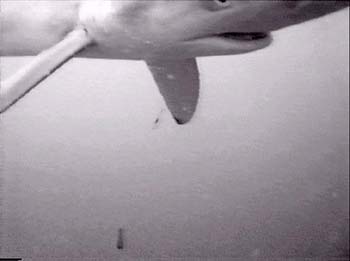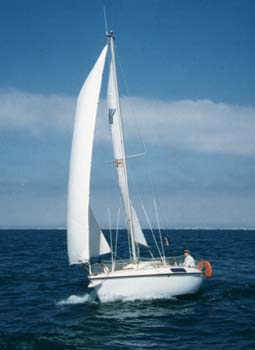On board Deïxon
ATV in maritime mobile
Finally, transmitting pictures between Port Camargue and Palavas on a sailing ship six meters long seemed at long to be very common; summer 2000 was thus the occasion to a new step by carrying out ATV transmissions with an underwater camera...
The underwater camera
I did'nt intend to send the family
camescope to the abyssal depths, the camera I use is a small black and
white one (the least expensive I found), sealed in a home made
plexiglass box, with O rings for passage of the shielded cable
with three conductors: video output, 12V supply, and common .
The cable measures 17 meters, thus the maximum depth where I can put the camera.
Leads you can see on the photography make it possible to sink; there is no stabilization, it oscillates at the rhythm of the underwater currents and of the boat to which it is suspended; results are then eminently unstable, in fact completely random, except when one poses it on the bottom.
Close
to the submarine camera, a perforated cylinder is filled with
crushed sardines in order to attract the client, future ATV star.
The monitor and the video tape recorder
The whole embarked apparatus is
supplyed by a 12 V automobile battery; the video signal coming up
from the deep seas passes by a video tape recorder and attacks a
small black and white monitor.
In fact, when the sea is flat, the camera is systematically under the boat, with a 240 minutes cassette in the video tape recorder ; during this time the operator can fish or take a nap.
The evening, back to home, I have to watch the cassettes at high speed, and to stop on the places where something is moving, that gives the picture at the end of this page.
the
transmitter, the antenna
If an ATV correspondent is present, the video signal is connected to the transmitter (1255, 2320 or 10 GHz), (on photography, we can see a transmitter on 2320 MHz and its quadruple quad (*) antenna not far from "la Grande Motte"); the transmission runs to F5ZGN, repeater at the top of mount Aigoual (1600 m) which retransmits it on 1255 MHz.
The Aigoual mount is about 70 kilometers away ; with 1W and this antenna, the signal is clicks free.
Some pictures
|
A worrying visitor |
 Second passage of the worrying visitor; is my camera eatable? |
A few moments of a rare violence occurred between these pictures and the following ones: the shark had had the bad idea to bait the line I had in the water.
Fifteen minutes later, everything was broken, and it came back with a bad regard:
I saw these pictures only in the evening, but I already suspected what had occurred under the boat.
My interlocutor was " a blue skin ", to be avoided, especially at this size; but for those who like the sea bathings, reassure you (a little), all this occurred 12 miles offshore and 17 meters down.
 The shark come back, it did not appreciate our last conversation; one can see below what is remaining with my line, my lead suspended to 65 cm of wire. |
 Finally this animal is not rancorous, and the cassette showed it 20 minutes long, prowling under the boat, eating the sardines I threw to bait; the hook probably in a hollow tooth, and my lead do not seem to disturb it . The 65 cm wire gives an idea of its dimensions |
 Other day, other visitor, quieter: a pastenague, whose dart can however be mortal. Dont step on it. |

The boat
She is a KELT 620, sailing ship six meters twenty long, allowed to navigate up to 60 miles offshore, its more than sufficient for good frights when arrives bad weather.
She is equipped on decametric bands (all bands) with the insulated preventer shroud being used as antenna (the preventer shroud is the cable which connects the top of the mast to the back of the boat), and on 144, 400, and 1200 MHz FM by a vertical triband placed on the mast. The transmitters are on board only when there is a project of particular traffic (marine corrosion ).
Her name: Deïxon
The legend of Deïxon |
| The
shepherd Deïxon and the nymph Onda werre passionately in
love on the slope of the Olympe mount; but the Onda nymph
was really very beautiful, and caused the covetousness of
Zeus, the king of the gods. Zeus did not support seeing its advances
refused because of a simple mortal and decided to
separate the lovers and to insulate them each one on an
island of Dodécanèse . Deïxon and Onda separated by miles were very afflicted when Deïxon, after observing dolphins jumping on the waves and disappearing far away , got the idea to entrust the waves with his missives to convey them to Onda. What they did with the aid of the winds. Zeus, disappointed but good loser, authorized Deïxon to join Onda riding on two dolphins, sent by Neptune, and entrusted Onda with the waves of the sea. |
Deïxon allows also fishing:
Largest catches
A 5 meters catamaran, with her two occupants (not brought back to home)
A splendid sailing ship 12 meters long, but she broke the line and escaped
A inflatable mattress (very common after Mistral) (Mistral is a local wind blowing strongly from the coast)
A basket
A large shorts
A bathing cap
Plastic bags to fill a whole supermarket; (the plastic bottle, although very frequent is very hard to fish because it does not offer a catch to the hook, its species is thus not in danger).
Other pictures
Fishes, offshore meetings (except the customs officers, which are enough surprised by the equipment on board, without moreover taking a photograph of them), sun ... click on fish , or boats
(*) in French
Return to the welcome page
© 1999-2011 A. Ducros F5AD